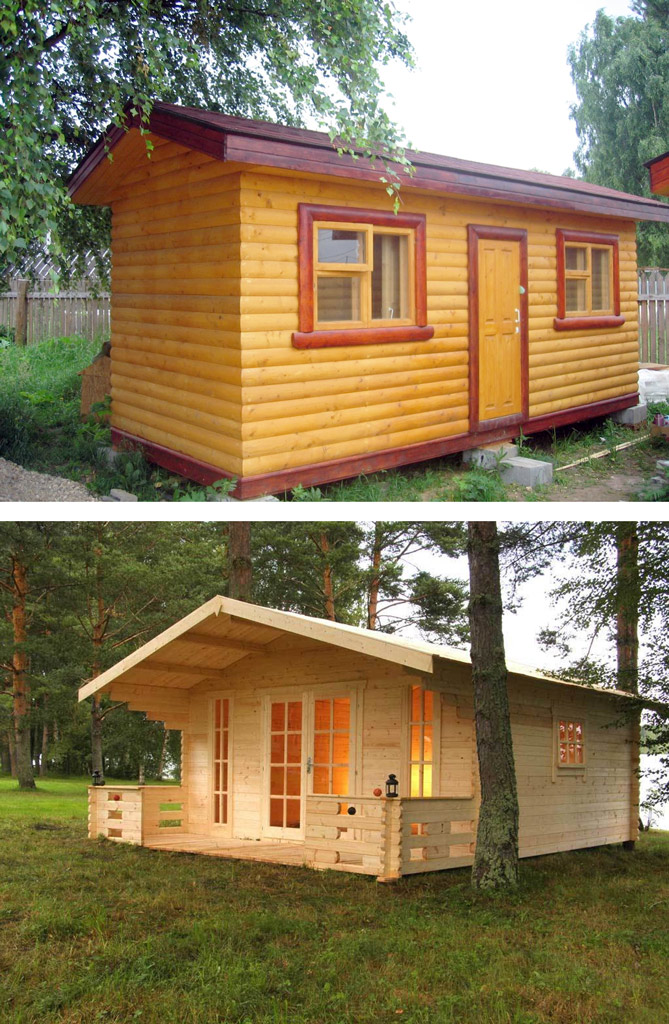
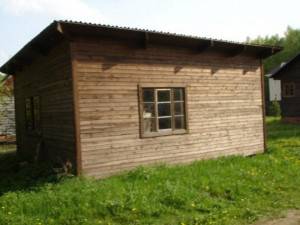
Do you have country house, but no utility room? Not in order. Whether you have a huge villa, a luxurious cottage or an ordinary country house, you need a utility room. There you will store various tools, personal belongings, etc. Have you decided? Then don’t rush to run to the builders, you can make such a utility room yourself, and we will help you with this!
DIY utility room preparation:
Let’s say right away that the house should look aesthetically pleasing, presentable, but in no case pretentious. Choose a place for your future utility room: somewhere on the edge, so that it doesn’t catch your eye, it doesn’t take up much space, but it’s roomy, so that everything you want can easily fit there, and there’s still room left. So decide on the dimensions, draw a drawing. For example, your utility room will be 4 by 3 meters, 3.5 meters high with a regular pitched roof. Don't forget to indicate the door and window on the drawing. A window in the utility room is simply necessary as it is an additional source of light and ventilation.
Stock up on tools. To make DIY utility room Of course, you will need the following tools:
1. bayonet-shovel - two pieces;
2. regular shovel;
3. The wood hacksaw can be replaced with a jigsaw;
4. hammer;
6. screwdriver.
As construction progresses, you will need several other tools, but more on that later. Consumables and building materials. If you want a durable, solid, attractive utility room, you will need:
2. disks of different sizes;
3. foam blocks;
4. plywood;
6. material for floor insulation ().
1. nails;
2. self-tapping screws;
Start building the utility room:
We chose a place, drew up a drawing, prepared all the necessary tools and consumables for building a utility room, building materials, now we prepare the surface: we clear the plot of land chosen for the construction of a utility room. We make markings according to the drawn up drawing.
This can be done with regular thread or braid. It is wound around pegs installed around the perimeter of the future building. After which we begin to dig a trench for the foundation, the dimensions of the trench for the foundation are width 400 depth 800, other dimensions according to the size of the utility room.
However, there are recommended dimensions: depth of at least 60 cm, width of at least 30 cm. The foundation must still rise above the ground, at least 20 cm above. By the way, you need to dig slowly, but efficiently, take care of your health and do not deviate from the markings.
Formwork and pouring the foundation for the utility room:
After the place for the foundation has been dug, you need to make a cushion of sand 10 cm thick, and compact it properly, it’s time to put up the formwork. You will need bars with a section of 5 by 5 cm, high-quality plywood with a thickness of at least 1 cm, a height of 35-40 cm, and a length of your choice.
The formwork gives the shape to your future utility room, so you need to set it up as evenly as possible. To make this happen, we either drive the bars in or simply lower them into the hole under the concrete. Then, from the inside, using a screwdriver and self-tapping screws, we fasten one to the other.
The gaps between the bars should not be more than 60 cm. With a height of 20 cm high pressure It simply won’t and there is no need to further strengthen the formwork; it will withstand the weight of concrete.
After all the procedures completed, pour the concrete. You can mix it yourself, or you can order a special machine, which I recommend you do, since a homemade solution will be worse and most likely will begin to peel off over time (tested by experience and time), it is better not to skimp on this matter. This point is very important, either by yourself or with the help of something, the main thing in this process is to let the concrete sit well, most often this takes two days. After this, we remove the formwork and continue construction.
Construction of the walls of the future utility room:
While the concrete is infusing and hardening, bring in foam blocks and cement. You will also need a concrete mixer or construction mixer. Of course, you can make the solution manually; you won’t need much of it, since you will install the blocks only halfway, in their same width. But you will be doing this for a very long time, thereby delaying the construction time. Preparing mortar for laying the walls of a utility room is an extremely serious matter; if the mortar is prepared incorrectly, you will have to think about guaranteeing the quality of the masonry.
Now we apply the first layer of mortar to the foundation, and install blocks from one of the corners. At the same time, we constantly check the level and compact them with light blows of a hammer. We coat the next block with the solution on the side of the connection with the adjacent blocks and install it evenly and tightly in the same way as the previous blocks. This will install the first fundamental layer. In places where windows and doors are provided, lintels are placed, usually a block or metal channel on which bricks are placed.
It is advisable to start the second layer from the same angle as the first, then the installation will be very strong and will look much more solid and aesthetically pleasing. Place the first block of the second layer so that it looks like brickwork in larger sizes. This means that the blocks of each row should half overlap the previous one. Don't forget! Openings for windows and doors of the utility room.
Installing a ceiling in a utility room:
Well, the foundation has been installed, the walls are firmly held on it, now you need to wait one day for the walls and foundation to “establish” their positions. And only now do you begin to build the ceiling. You will need boards at least 50 mm thick and 200 mm wide. Using self-tapping screws and nails, we attach these boards to the finished walls and fill in the gaps. It's best to blow this one out polyurethane foam not just the gaps, but all the corners. Special foam will protect against moisture penetration and drafts. We produce, and the ceiling is ready.
Cultivation of the roof of the utility room:
The last step in the construction of a utility room, but one of the most important. A slight slope on the roof is required. It can be made using 1-meter bars with a cross-section of 20 by 20 cm. They can be fixed to the ceiling using self-tapping screws that are screwed in at an angle of 30-35 degrees. Install these bars at a distance of 50 cm from each other. Now make a frame from boards on which to install the roof itself. To give the structure strength, you can duplicate the bars, making them smaller and installing them approximately in the center of the structure.
So we made the utility room with our own hands, all that remains is to properly equip it and try not to clutter it up, as often happens.
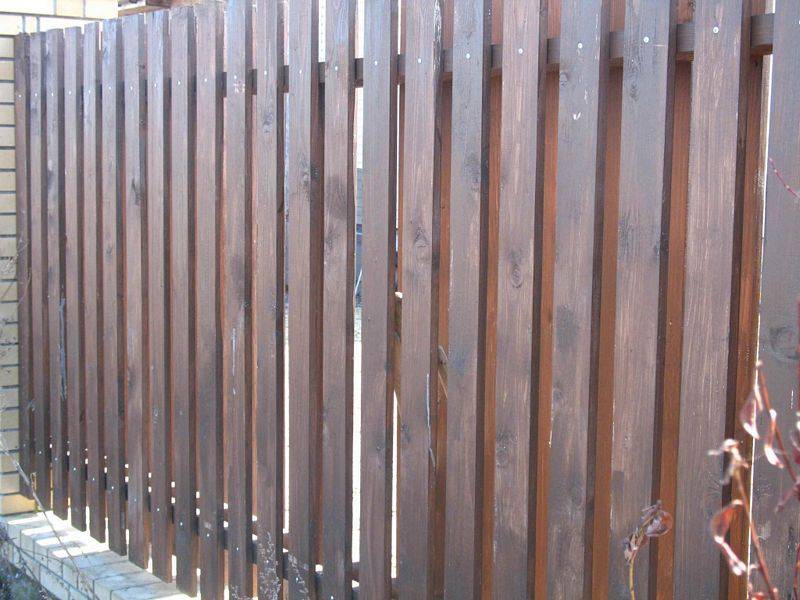
Required attribute country house or a dacha is the presence of small buildings in the yard, the so-called utility block. The utility block is an auxiliary room for storing tools, various auxiliary materials, equipment and large quantity all sorts of things that had no place in the apartment building. In addition to storing equipment and tools, outbuildings are designed for storing crops, firewood, keeping pets and poultry, arranging a shower and toilet, a greenhouse, a greenhouse, a cozy summer veranda and even a carport. The number and purpose of such buildings depends on the needs and imagination of the owners.
- The technology for constructing a utility block is relatively simple, for those who have at least a little experience in such work. A utility block, or as it used to be called a barn or a change house, can be built independently.
- First of all, you need to choose a place in the yard. The utility block is usually located deep in the yard or behind the house, away from prying eyes.
- It is undesirable to choose a place in the lowlands, since moisture accumulating there will quickly render a simple building unusable.
- Clay soil is also not very favorable, but if there is no other option, it is important to carry out preparatory work first, and only then proceed with the foundation. A basic cushion of sand and crushed stone will make the foundation more durable.
- But sandy soil is an ideal option for building a utility block. In this case, you just need to prepare the soil and you can start construction.
Utility block layout
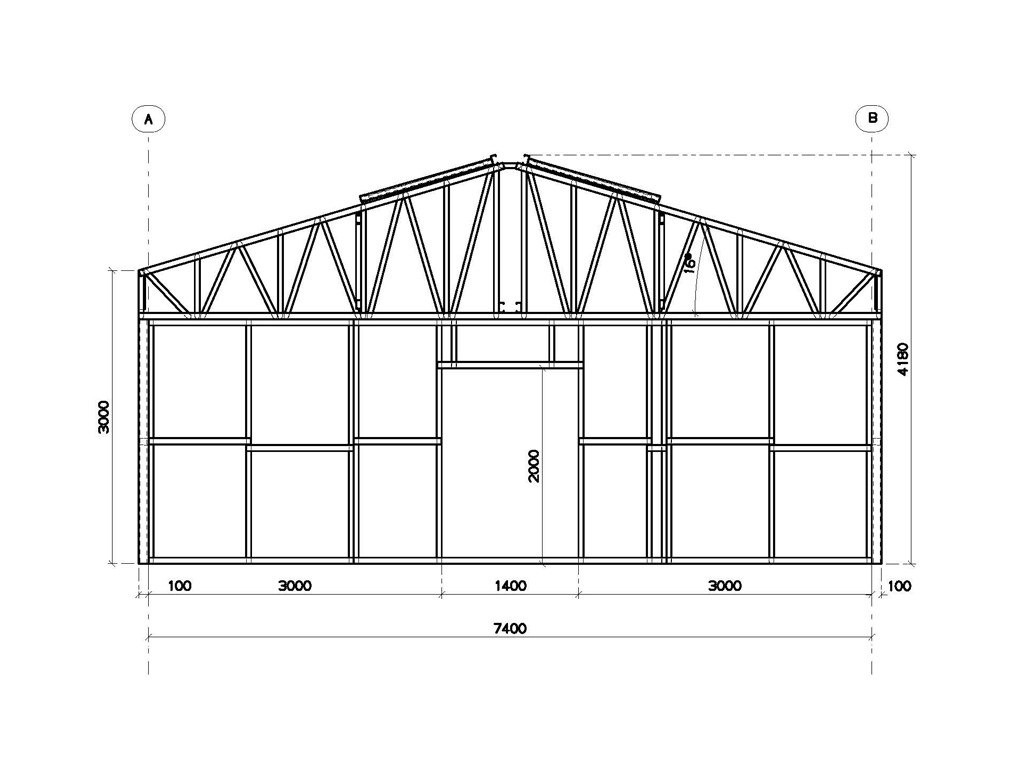
- Many free-standing outbuildings, not decorated personal plot. In addition, their construction requires a lot of material, they occupy a significant part of the site and all together look unaesthetic. It is much more rational to plan one utility building, internally divided by partitions for rooms for various purposes.
- If the plot of land is small and you want to devote the main space to a garden and vegetable garden, then they build a multi-storey building. And it has already been equipped with an underground floor, a cellar for storing crops, a place in the attic for a greenhouse or seedlings, and even cages for pigeons.
- If the building is planned to be used in winter time year, it is necessary to provide for wall insulation. Using the outbuilding as a summer kitchen presupposes the presence of a stove there.
- When planning the construction of a utility block, try to provide for everything possible options. Therefore, a drawing of the site with the planned dimensions of the utility block is a mandatory preparatory stage.
Construction of a utility block: requirements and standards
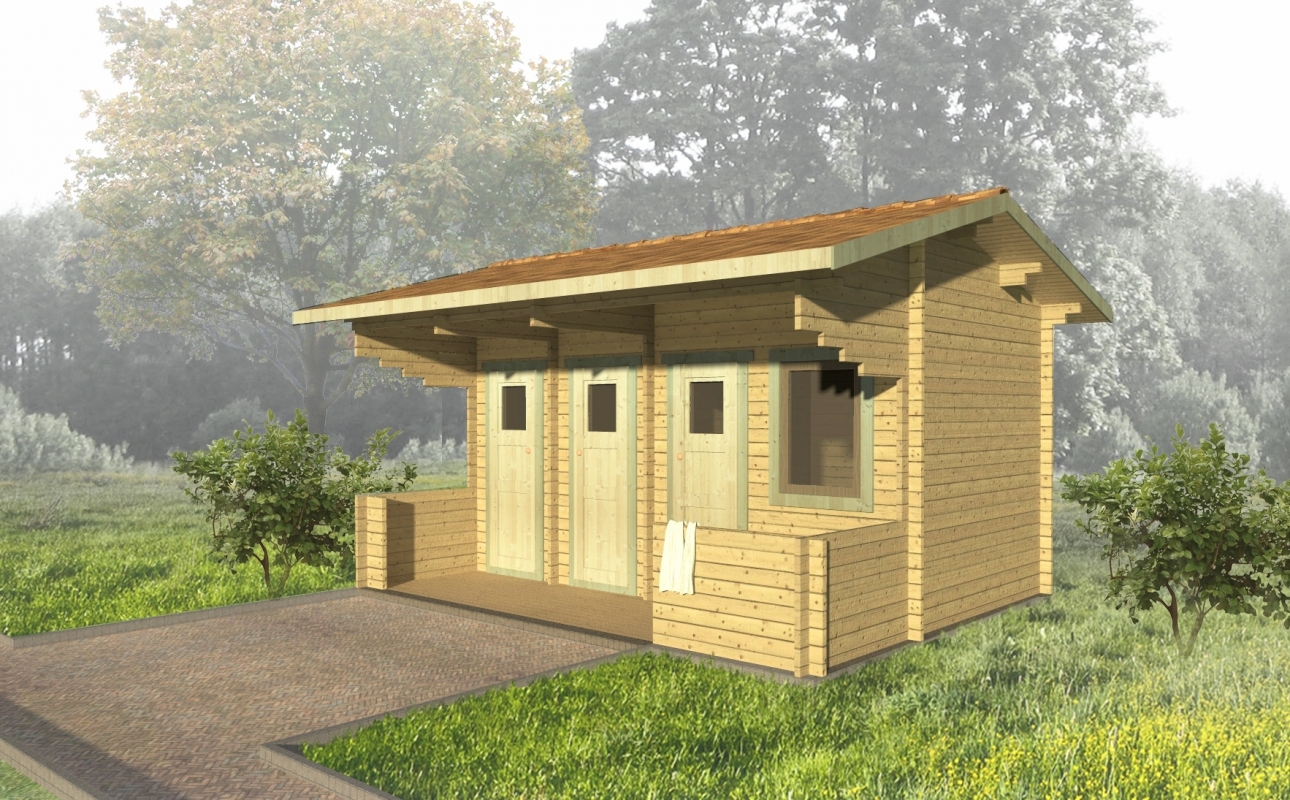
- In order to save the area of your site, do not neglect the requirements of SNiP 30-02-97. This document regulates the size of the minimum distances from a commercial building to the walls of a residential building or a neighboring plot. Depending on how the planned premises will be used, these distances will be different.
- If the utility block will be intended for keeping livestock or a toilet will be equipped there, then according to the standards it can be built no closer than 12 m to the walls of a residential building, and no less than 4 m to the neighbors’ property.
- It is allowed to equip a shower or bathhouse no closer than 8 m from the house, and no less than 1 m from the neighbors.
- Even 1 m of land between the new building and the fence can be effectively used. The option is considered especially successful if the neighbors’ utility blocks are located opposite each other with their back walls. This way you hide the unsightly rear side of the business building.
- Once you have decided on a location, try to distribute the space as efficiently as possible. If heating is not necessary in the outbuilding, then you certainly cannot do without electricity in the utility room.
- Remember that the building must last for more than one year, so construction must be taken seriously. The first step is to decide on the format of the foundation construction work.
Hozblok: types
Buildings for outbuildings can be wooden, combined frame-modular and metal. Standard project represents a building for utility purposes, with a toilet and an outdoor shower on both sides.
Do-it-yourself wooden utility unit
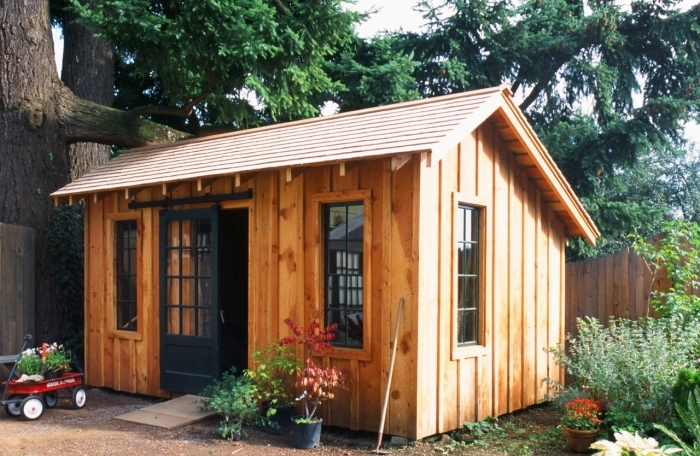
A wooden structure always begins with laying a foundation on a pre-selected and prepared site.
We treat the soil
- The top layer of earth at preparatory work must be removed.
- However, make sure that the depth of the excavation is not less than 0.5 m.
- According to the rules, the depth of the foundation depends on the level of soil freezing and should be a little deeper.
Preparing the pillow for the foundation
- The next step is to pour sand under the foundation onto the prepared soil, and then a layer of crushed stone. The result is a simple pillow for the foundation.
- If the thickness of the layers turns out to be a little more than 10 cm, it’s not scary, but this level is already quite enough for the further construction of the utility block.
Laying the foundation
- Reinforcement in the form of a mesh is already laid on the finished cushion, then formwork is made, which is filled with concrete.
- During the hardening of the reinforcement, which is usually about 2 weeks, it is important to regularly moisten the surface of the foundation.
- Some builders prefer outbuildings pile foundation. If the frame is entirely wooden, then its base is first assembled from wooden beams, and then covered with facing material. Planed boards are considered the most suitable material for this.
- To make wooden beams last longer, they are well treated with an antiseptic and then painted.
- The best option is to secure the boards vertically. In this case, additional cross bars are provided for installation to the frame.
Making a roof
- The roof structure of the utility block can be either single or gable. For its construction you need:
- rafters;
- sheathing;
- thermal insulator;
- waterproofing agent;
- roofing materials.
- You can also use slate or galvanized metal sheets as a roof.
- The ideal option would be pitched roof, covered with slate. But under no circumstances should you make the roof of the utility block flat; water accumulating on it will quickly destroy the wooden building.
- Can also be combined wooden walls buildings with brickwork. To do this, first a low base is laid out, then several rows of bricks and then a wooden frame is installed.
Do-it-yourself frame-modular utility unit
If a wooden outbuilding can be painlessly built without a foundation, then for a frame structure it is necessary. It is this kind of structure that will meet all the requirements for the construction of this type of building, and its service life will be counted in decades.
Marking and preparing the soil
- The construction of a frame-modular utility block begins with marking the perimeter of the future foundation.
- Once the area has been determined and marked with strictly parallel lines, we begin preparing the land. Remove 20 cm of the top layer and add 10 cm of sand. We pack everything tightly.
Laying the foundation
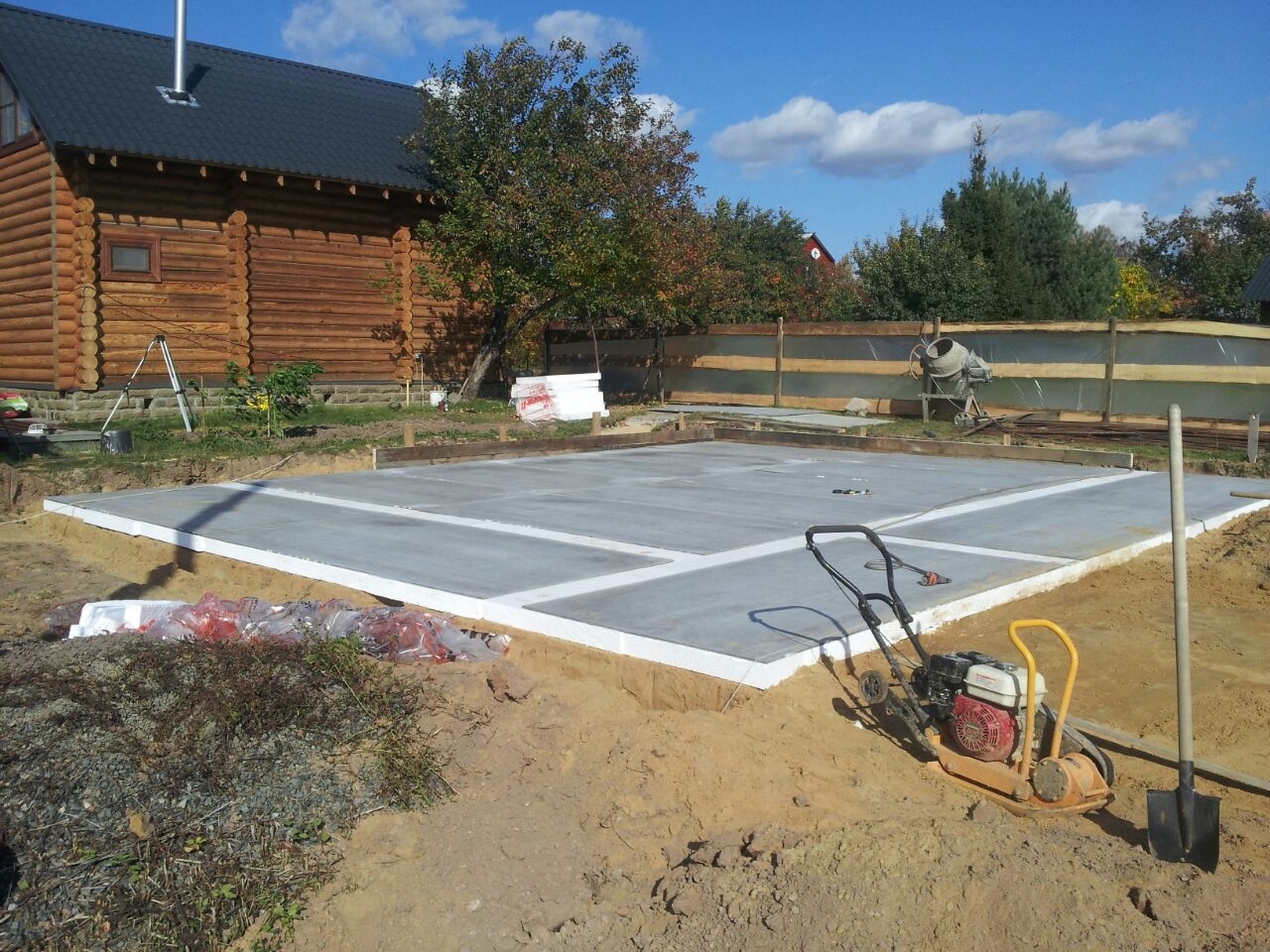
- In the corners and in the center of the long wall we prepare small-diameter holes for posts about 1 m and 2 m deep.
- Pour fine gravel or sand onto the bottom.
- We place a column of the appropriate length in each blank.
- The pipes must be installed strictly vertically and fixed in the hole with sand poured into the remaining free space.
- We pour concrete or cement mortar about a third of the height, and then slightly raise the pipe. This way we get a solid foundation for the foundation pillars.
- The next step is to fill the pipe cavities with concrete solution to the very top.
- For additional strength of the pillars, reinforcement is usually additionally installed in the holes, the ends of which must protrude at least 20 cm above the level of the pipes. When pouring the solution, control the ingress of air. The resulting bubbles will have a bad effect on the strength of the cement.
Installing the frame
- After the foundation has hardened, you can begin attaching the frame. Depending on the design of the utility unit, it can be either wooden or combined with load-bearing metal profiles.
- First, we install load-bearing profiles with a cross-section of at least 10 cm, and then we attach the rafters to them using self-tapping screws. It is important to prepare the holes for fastenings in advance so that the wooden planks do not crack during installation.
Installing the roof
- The optimal solution, in terms of material costs and installation complexity, is a pitched roof with frames of different lengths. In this case, we install horizontal and vertical racks at equal intervals within 50 - 60 cm.
- The roof is usually covered with bitumen or profiled sheets. It is more convenient to assemble it on the ground, and then install it ready-made on the frame. Make sure that its angle of inclination ends up being no more than 10°C.
We do cladding and interior lining
- Having finished assembling the frame of the utility unit, you can begin attaching the inner lining. It is usually made from slabs.
- We lay heat-insulating material on the outside, and attach the cladding on top of it.
- As an external material, you can choose either lining, corrugated sheets or any other facing material at an affordable price.
Installing walls and laying floors
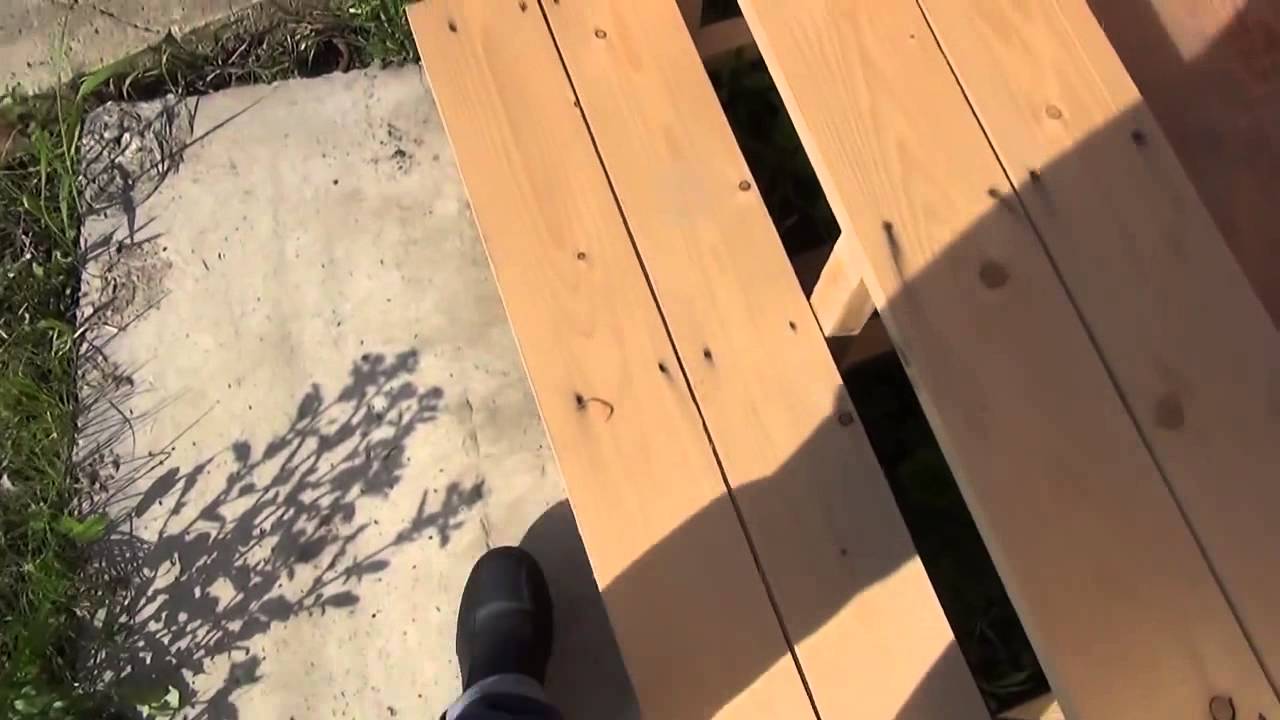
- Now you can start building the walls. Their number will directly depend on the planned rooms, bathroom, shower and other premises.
- It is important not to forget about windows and doorways. To do this, you can use ready-made window structures or make special fastenings from beams for the necessary openings of windows and doors, which will subsequently serve as slopes.
- Finally, we cover the walls and roof with sheet iron.
- The floors in the utility room will be made from planed boards. If you nevertheless choose a material from an untreated board, it will still need to be pre-planed and it is better to cover the floor with linoleum on top.
Taking a shower
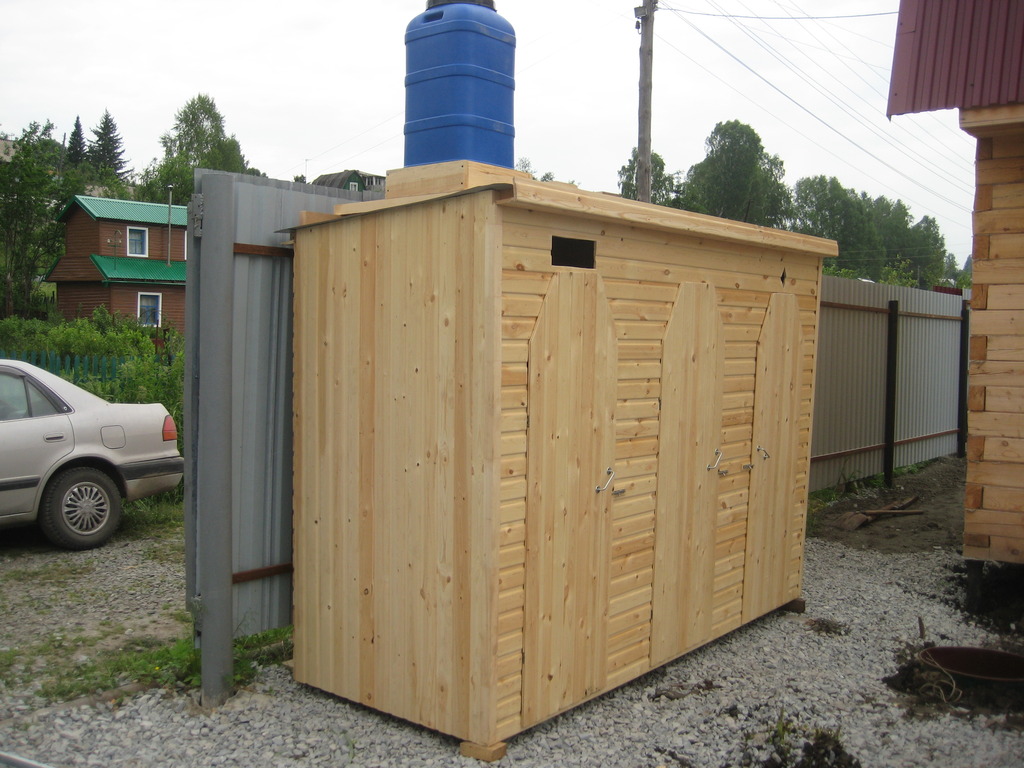
- If in the utility block you have planned summer shower be sure to install a water tank on the roof. Paint it black. This way, in summer, a container of water will attract more sunlight and there will be no need to additionally heat the water.
- If you decide to supply hot water in the outbuilding year-round, you need to install a special device consisting of an iron container with a lid, at the bottom of which there is a drain hole, and a heating element installed inside. The supply of electricity to such a utility unit goes without saying.
We design a bathroom
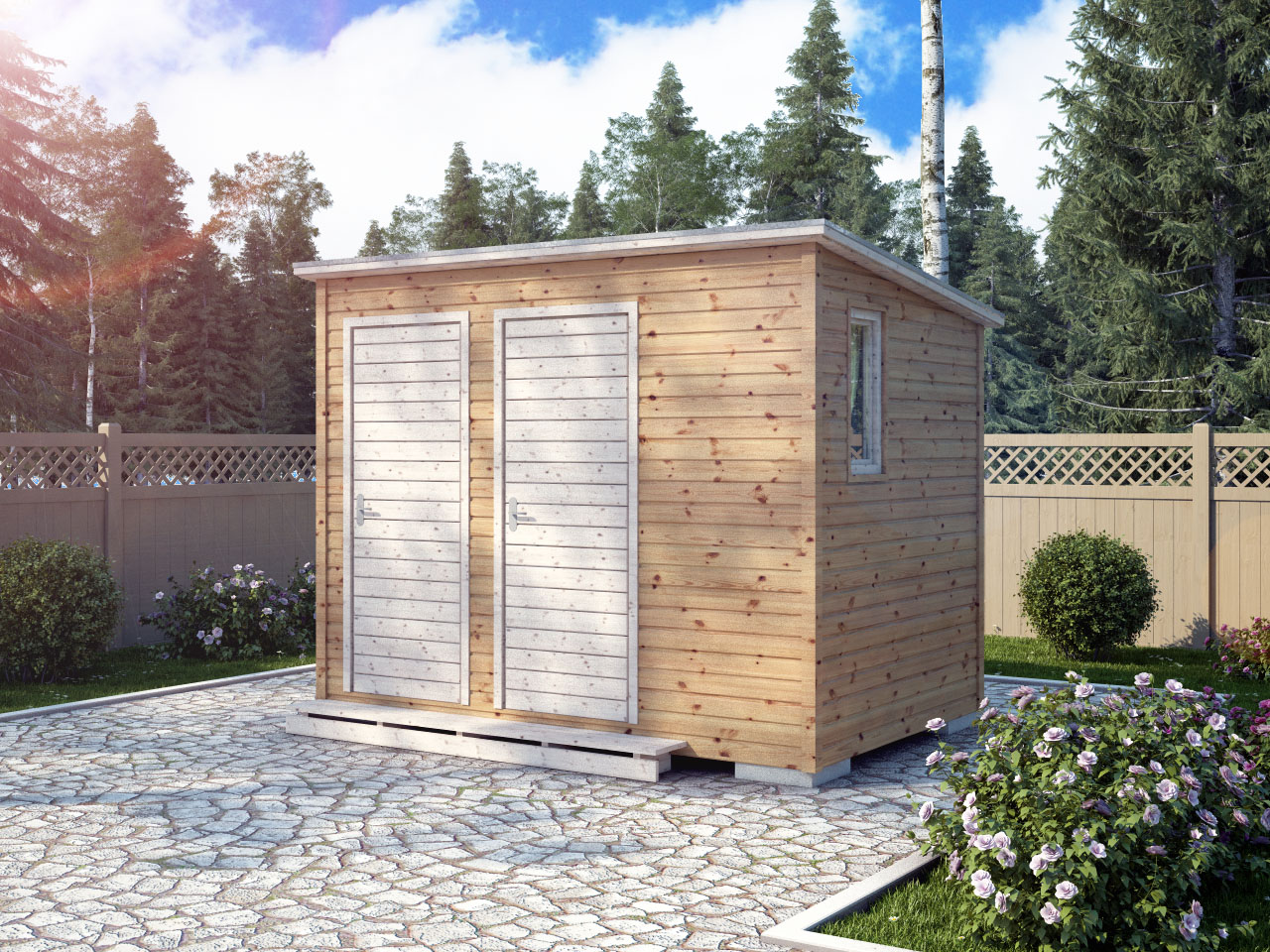
- The most basic bathroom can be built using a strong board fixed above the cesspool.
- It is also possible to provide for the installation of a dry closet or the installation of full sewer drains.
We insulate the walls and do the wiring
- At the owner's request, the building can be insulated with thermal insulation materials. It is important to treat the outer part of the walls with a pest control treatment before doing this. This will make the utility unit more durable. The use of moisture-proofing materials will protect it from the harmful effects of moisture, and fire-retardant impregnation will protect it from fire.
- Electrical wiring can be laid both externally and internally. Typically, wire lines are hidden in special insulating boxes in accordance with mandatory standards for protecting structures from fire.
Do-it-yourself metal utility unit
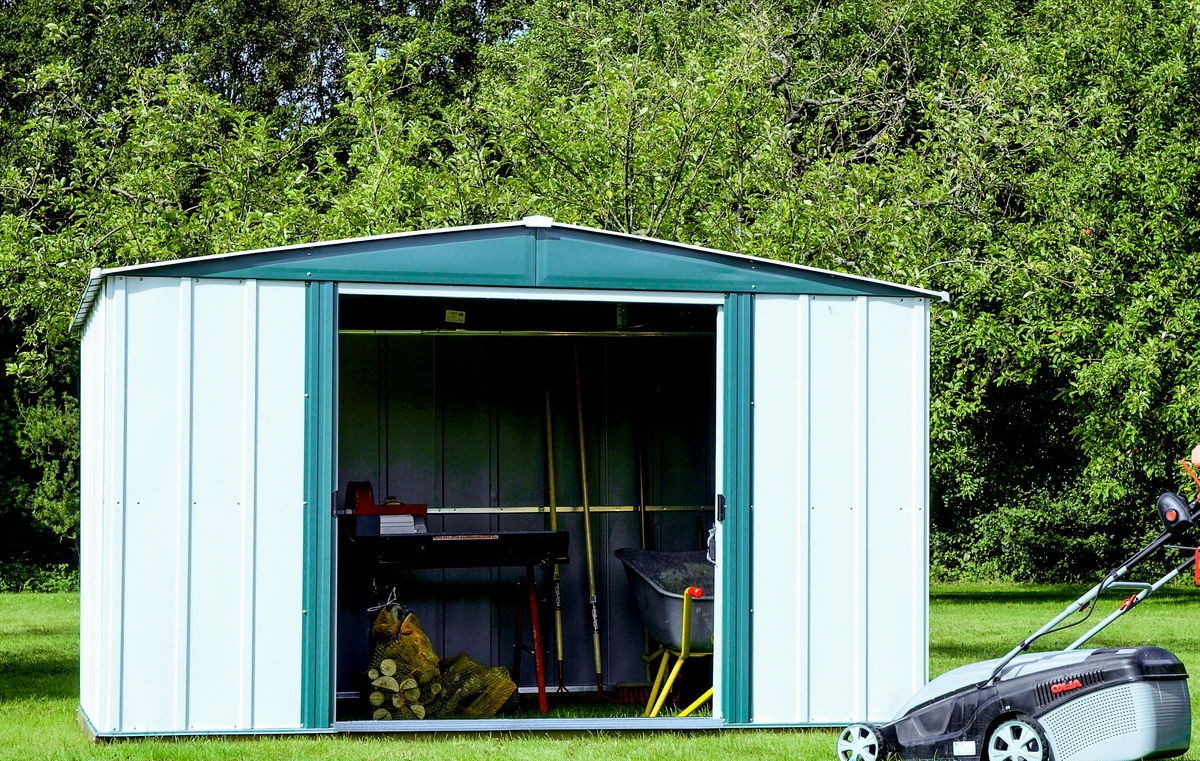
- The simplest, most economical and popular option for a utility unit is a metal structure. Such structures have become widespread due to their low cost, simplicity, durability, ease of use and minimal installation time.
- There is a wide variety of similar designs. There is no need to pour a foundation for them; they are mounted on any flat surface, including directly into the ground. There are also options for metal structures, in which rooms for showers and toilets are already provided and equipped.
- Welded structures, unlike metal frames, are stronger and more durable. The reliability of such structures is higher, but they are quite complex to manufacture. To make them you need strict adherence dimensional accuracy of structural elements. The only drawback is that subsequent dismantling of utility units of this type is practically impossible, and accordingly moving to another location is extremely difficult.
- There are options for small prefabricated outbuildings made from ready-made monolithic blocks. The blocks are sold separately, but are delivered to the buyer already assembled, which facilitates the effort and time for their installation. The only drawback is that it is impossible to install such a structure without special equipment.
Such a small but universal structure as a utility block is a necessary element of any summer cottage and country house. This structure usually appears on the site even before the appearance of the house, accompanies the construction process, and subsequently throughout life on this site. In the era of modern technologies in construction, you can easily buy a ready-made utility block or hire a team of professionals to build it, or you can make it yourself. In addition to the fact that the owner’s soul will be invested in this building, a self-built outbuilding for various little things will cost at least half as much.
Nowadays, many summer residents are interested in how to build a utility block correctly with their own hands, because this is an extremely useful room.
Its usable area can serve as a bathroom, shower, storage room, tool storage, or turn into a summer kitchen or barn.
The article describes how to properly build a utility block (instructions are provided) to make your summer cottage more comfortable.
What is it used for?
The dimensions of the utility unit are usually small, but at the same time, the entire area is universal and functional, since it is not limited to specific boundaries and can be used for a wide variety of things.
Initially, such utility blocks and sheds were filled only with construction or gardening tools, but over time, they were increasingly modernized, and now it has become commonplace to make a bathroom or summer kitchen in them.
Manufacturers have even begun to produce ready-made structures for a shed, toilet or shower, which can be purchased both disassembled and finished; their photos are posted on the manufacturers’ websites. As a rule, assembly drawings are included with such kits.
If you decide to build a utility block (shed, toilet, shower, etc.) on your own, then you will need detailed step-by-step instructions.
Where should the utility block be located?
Before choosing the location of the building, you must first decide on its purpose:
- If the utility block will be used to house livestock, poultry or a toilet, then it should be placed no closer than 12 m to the residential building and no closer than 4 m to the neighboring plot;
- If a shower room is planned, then the distance to a residential building can be within 8 m, and up to neighboring plot 1 m. The remaining meter to the border with the neighbor can be used as a place for firewood, stairs, or other equipment;
- The most convenient option is to build one large functional utility block, rather than placing small sheds around the perimeter, eating up the space of the dacha. The scheme of this structure combines an outdoor shower, toilet and utility room, placed in the middle;
- Also, to save the area of the dacha, it is possible to build a multi-storey utility block. Often construction involves an underground floor, using it as a cellar or compost pit. Above you can make a workshop, pantry, bathroom, summer kitchen and even a place to sleep. If necessary, add an extension in the form of a barn for livestock and poultry. The construction also involves the creation of an attic for storing hay or breeding pigeons;
- If you plan to connect the utility unit to some premises, then it is better to choose garden house. In this case, the barn is connected to the blank wall of the house, which is located on the north side.
Selection of material for the utility unit
The construction of a utility block involves the use of various materials.
Quite often, the frame for a utility unit is made from a metal profile.
The use of metal profiles with the LTSC system (lightweight building thin-walled structure) allows for simple installation in a short time.
Frame construction involves the use of metal profiles as an analogue to a wooden frame.
But most often they still make a utility block from corrugated sheets. Using the frame method, a barn is erected from wooden blocks and sheathed with profiled galvanized sheets.
In the photo you can see examples of such utility units.
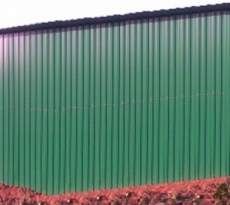
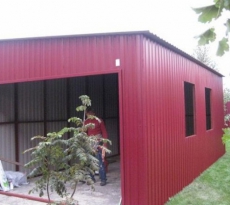
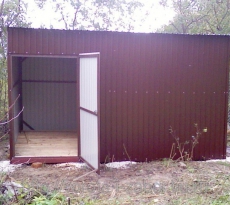
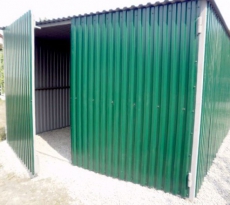
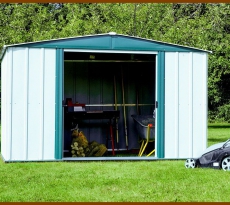
Advantages of a utility unit made of corrugated sheets
Corrugated sheets used in modern construction have many undeniable advantages.
Here are the most famous of them:
- light weight;
- quick installation;
- presence of anti-corrosion coating;
- long period of use;
- wide color palette.
We begin the construction of the utility block
Such sheds and frame sheds must be made strictly in a certain sequence. It is best if you have the relevant drawings in front of your eyes during construction.
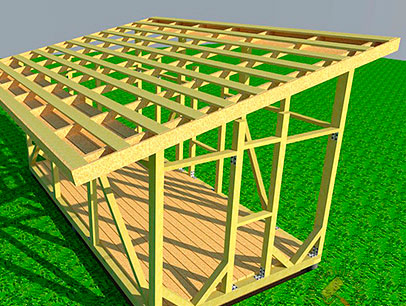
The steps are quite simple:
- create a strong foundation;
- prepare the base;
- build a frame;
- raise the walls and put on the roof.
Afterwards, you can begin to insulate the building and carry out the interior and exterior finishing of the barn (using corrugated sheeting and other materials).
Step #1
To create a foundation with your own hands, we first make markings around the perimeter, marking the placement of pillars (pipes) in the corners and in the center of long walls.
We prepare the soil - remove the turf and fertile soil, approximately 20 cm deep, add a 10 cm layer of sand and tamp it well, creating a foundation.
We make holes for pipes with our own hands, to a depth of more than 1 m.
We also prepare the bottom of the pits in advance. We place a layer of fine gravel or sand down and compact it thoroughly, creating a foundation.
To ensure a strong foundation, we install the pillars exclusively vertically using a building level, and fill the remaining space with sand.
Fill the hollow parts of the pillars 1/3 with cement solution, then slightly raise the pipe.
This method creates a solid foundation of concrete base and holds the pipes vertically at the desired angle.
Afterwards, fill the pillars completely with cement mortar so that no voids form inside - this will be the foundation created with your own hands. The cement will harden for quite a long time, this requires at least 2 weeks.
During this time, it is better to cover the foundation from the sun and periodically irrigate it with an aqueous solution.
Helpful advice: to improve the fixation of the pillars, reinforcement (or pieces thereof) is mounted at the base of the beam and also filled with mortar.
If desired, the reinforcement can be replaced with anchors by securing the beam frame to the foundation with nuts.
Step #2
While the foundation hardens, we assemble the base of the frame. From thick timber at least 15 cm thick, we build a rectangle, making the long side 6 m and the short side 3 m.
To fasten the grooves we use self-tapping screws (2 pcs for anchors, 4 pcs for reinforcement).
We make a layer in the space between the foundation pipes and the wooden frame. For the layer, we take roofing felt and use it, bending the ends inward to avoid moisture accumulation on it.
Also, to treat roofing felt, we take an antiseptic. This will repel insects and prevent mold from occurring.
Afterwards, we strengthen the resulting frame for the utility block with the help of 3 transverse logs, placing them at intervals using timber 10 by 10 cm thick.
Step #3
We build the frame of the utility block with our own hands from timber 10 by 10 cm thick and 15 by 15 cm thick. We make the front part of the building using timber 3 meters high, the back side is made of timber 2.5 m.
Thus, we specially create a frame for a pitched roof.
We begin to make the frame from the end walls with window openings. We place the corner posts on the base of the reinforcement.
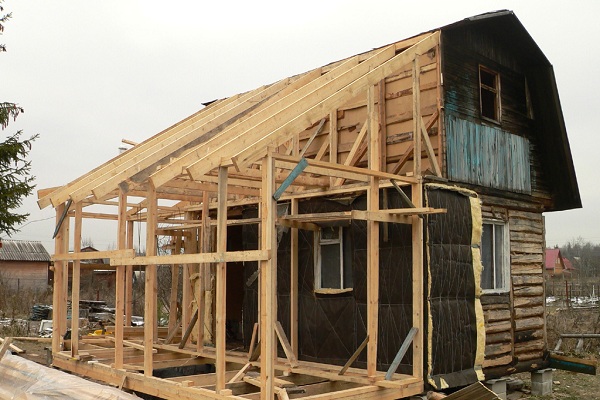
The location of the beam should be vertical at an angle of 90 degrees parallel to the window openings and doors. In addition to the corner bars, we add 2 bars to the end frame.
We also place 2 or 4 beams on the front part of the frame and on its back side. To increase rigidity, we install oblique bars between them.
We install the upper and lower lintels on the end walls of the utility block between the 2nd and 3rd beams to create windows there.
We also place vertical bars on the front wall with the entrance door being 85 cm wide and 2 m high. We place the doorway in the middle of the wall.
Step #4
We assemble the rafters on the ground with our own hands in a horizontal position. Then we lift them and install them on the shed. The slope of the roof should be about 10 degrees.
We fasten the rafters with self-tapping screws, using an edged board, and sheathe the cornices and overhangs.
With proper construction, you can end up with a wide variety of outbuildings and sheds.
The photo below shows several finished designs.
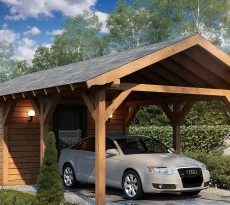
![]()
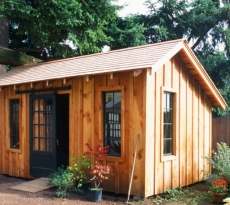
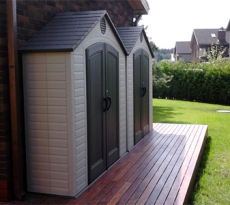
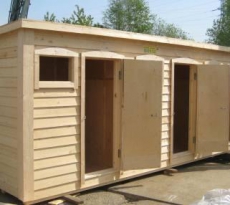
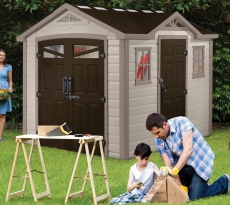
Helpful advice: to prevent cracks from appearing when attaching the screws, it is better to first make holes for them.
How to sheathe the utility block?
The frame can be covered with your own hands using corrugated sheets. To fasten the corrugated sheeting, we use self-tapping screws for metal or roofing, using a screwdriver.
Fastening the corrugated sheets begins from the bottom tier, so that the top layer overlaps the lower sheets of corrugated sheets.
The corrugated sheeting layer does not save heat, so the frame of the utility block is additionally insulated with foam plastic or mineral wool. However, the use of corrugated sheets is mandatory.
Toilet arrangement
Build proper toilet with your own hands, so that the smell from it does not penetrate into other rooms and spaces in the country house is almost the main task.
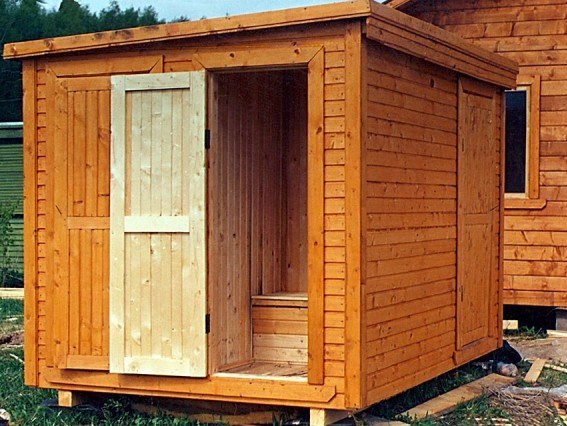
Many people organize a toilet in the utility room, but there are several important nuances:
- It is necessary to think in advance about how you will dispose of waste. The most commonly used for this purpose is a cesspool;
- Its volume is selected individually, taking into account the number of people who will use the toilet;
- If the toilet and shower are separated by one partition, you can make one common cesspool. If no more than 2 people live at the dacha at the same time, then the easiest way is to use a dry toilet with a chemical base. Such a toilet can be installed on any side of the utility unit; if desired, you can even use the resulting waste as fertilizer;
- Helpful advice: for comfortable use of the toilet, it is better to insulate it from the inside with your own hands using a layer of polystyrene foam, using thin plywood for lining. It is also advisable to provide ventilation above the door with the toilet.
Shower device
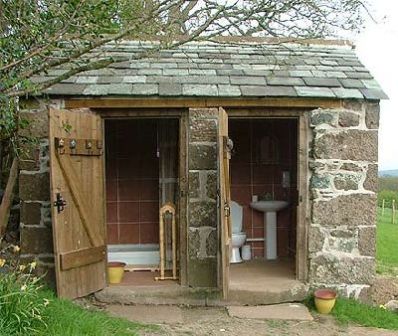
You can build different showers in the utility room:
- Some people use a shower with a regular shower head, using a hole in the floor to drain the water. And some people prefer to install an entire shower stall, while connecting pipes for the supply and drainage of water. These preferences depend mainly on the price of the issue, because not everyone can use an expensive shower in the country;
- You can also heat the water in the shower. If this is not possible, then the water tank is installed on the roof or sunny side so that the water heats up sun rays, and you could use a shower with warm water.
Conclusion: following the instructions and using necessary materials, you can easily create a utility block at your dacha with your own hands.
Having acquired summer cottage plot, the first thing you should tackle is a do-it-yourself change house. Why a change house and why your own? Because the complete arrangement of a dacha will take more than one day or even more than one season, and no one can stand spending the night and hiding from the rain in a car for that long. A tent is also not an option: where to wash and cook food in bad weather? And with their own - because the prices for ready-made country cabins are by no means low and their durability often does not exceed 5-6 months. At the same time, in a small room for temporary short-term stay and household needs (which is a change house) there is nothing that a person with absolutely no construction experience could not do on his own. During the construction process, it is acquired, which will be useful during the construction of a house, and other things that are necessary for a good rest in the country. AND A properly built shed will then serve for a long time, being very useful on the farm.
Change houses are sometimes called temporary buildings, meaning that they are removed when no longer needed. This idea was formed under the influence of people employed in field work, especially builders. There, indeed, upon completion of the project, all temporary trailers are dismantled or taken away. The same builders were the first to think of building a change house in the country. During the Khrushchev dacha boom, they were also given land, and they took on a quick fix build something like your own locker rooms, warming rooms, foreman's rooms, etc. At that time, building materials for ordinary citizens were not widely available, and the construction of a good country house could drag on for years with the full skill and ardent desire of the happy new owner of the site.
Since the change house was supposed to be used for a long time, people soon developed inexpensive designs that required a small amount of materials, but were comfortable and durable. It was a pity to break them later, and in the cabins they initially began to place a utility block in a dacha type 3 in 1: a bedroom-shelter, a storage room/warehouse, a toilet with a shower. In this form, the country house has survived to this day, only externally it has been improved, see Fig: building materials have become more accessible, and demands for aesthetics and quality of life are higher.
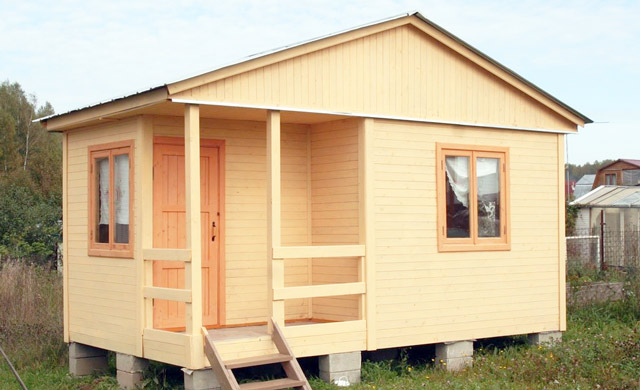
The meaning of a change house
The household pioneers of the past often still had to disassemble their creations due to the same shortage of materials, if there were not enough of them for the house. But the modern summer resident immediately builds his change house for a long time. The current country house is designed to perform the following functions:
- Residential, while the site is being developed. In the future, the shelter room will be converted into a bathhouse, warehouse finished products, sparrowhawk-rabbit, utility room at the greenhouse, etc.
- The utility room is like a shed for household property and gardening equipment.
- Sanitary and hygienic facilities such as a locker room, a bathroom, a storage room for work clothes and shoes, a summer kitchen.
- Aesthetic - with the goal of removing all the unsightly aspects of country life out of sight.
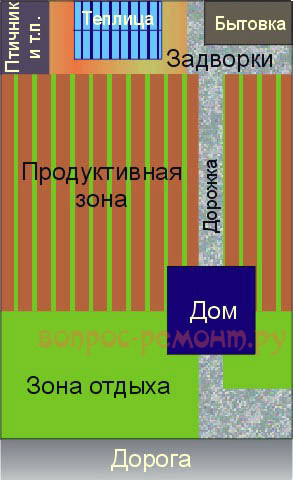
The point of this approach, firstly, is that the very concepts of the purpose of the dacha have changed. The current summer resident definitely wants to have a recreation area on the site with a pergola, decorative pond or flower garden, rock garden, barbecue, etc., even if the summer house is commercial and the family lives on the income from it. Therefore, a change house with a utility block and a greenhouse/greenhouse are placed in the backyard, and a recreation area is arranged in front of a beautiful country house, see fig. right. The robe and shoe covers are left where they worked; to relax or receive guests, they walk along the paved path already clean, without carrying clods of earth from the beds.
Secondly, a country house is essentially a bedroom and a living room. When it’s hot, you want coolness in it, but in order for the air conditioner (which can simply be stolen during the winter) not to ruin your budget, you need an expensive and complex capital structure with low heat loss and tightly closed windows/doors. But who wants to sit locked up in a dacha and make sure that the whole company doesn’t leave the door wide open behind them? What kind of vacation will this be? It’s easier to put blinds on the windows or hang awnings - and let the room be ventilated.
In this case, a kitchen, shower and toilet in the house will not add coziness and comfort. It will also be more pleasant for the housewife to cook in the fresh air, and not in the stuffy air; suddenly there is bad weather, you need to do your cooking under the roof, without bothering anyone and so that you don’t crowd around and make noise. In addition, the installation of a toilet is a very complex problem. The point here is: the sanitation requirements for the distance from water sources and residential buildings also apply to neighbors, plus it is necessary to ensure the possibility of access to a sanitary facility. And if you cooperate with the same neighbors, then the septic tank common to 4 adjacent plots becomes “like a native” at the junction of their borders; pumping is required less often, and may not be needed at all for years. And there is no need to destroy the earth by laying pipes from the house to the septic tank, which is expensive.
Next, you need hot water for the shower and kitchen. Installing a boiler or stove with a water heater in a house is again inconvenient; building a house with a chimney according to the requirements of the fire safety regulations is again difficult and expensive, but a stove fits into a change house much easier, because This premises is not residential. Finally, we live in the 21st century - in the summer electricity for a refrigerator with an electric stove can provide solar battery, A hot water – solar panel. Current prices for them are quite affordable, and some designs can be made with your own hands. But they will not add aesthetics to the house, but on the flat roof of the cabin they will stand “as they were there,” and will not be an eyesore to anyone.
Overall, everything suggests that you can and should build a summer cottage with your own hands for long-term use, but without the prohibitive costs and without construction experience. Is this possible? Yes, this article is intended to help in such a case.
Build or install?
The first thing that comes to mind is: wouldn’t it be easier to put a storage unit from a shipping container on a simple gravel bed? There seems to be minimal work. No, not the minimum - you’ll be so busy over the openings alone that you could even build a house. Ready-made cabins made from containers of various classes are on sale, see picture, but the prices are very high.

The reason is a lot of unnecessary metal for household use. No one will sell containerized cabins for less than what they cost as scrap metal, and there is a lot of iron in the container. However, we’ll remember about metal cabins later; in certain circumstances, this may turn out to be a good option. But in most cases, especially for beginners, a wooden change house turns out to be simpler and more profitable, so we will mainly deal with them.
What to build?
First, let's decide on the sizes. The smallest shelter cabin, combined with a storage room, has internal dimensions of approximately 2.5x3.5 m. A “2 in 1” cabin, with a warehouse separated from the living room by a partition, and a nook for the kitchen, will be already 3x4.5 m; We will talk about this in more detail below.
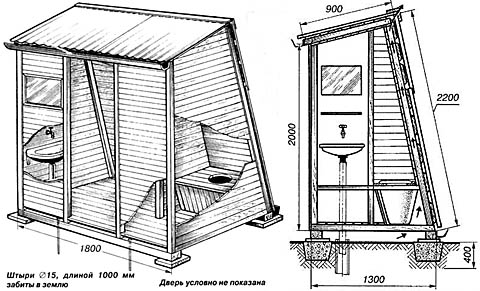
In both cases, you also need a small bathroom nearby in the yard; one of its long-known designs is shown in Fig. right. It uses a peat toilet, or powder closet. These days, a dry closet would be more hygienic. From those purchased for the dacha would be better suited a bio-toilet-bucket with replaceable absorbent cartridges, but you can make a bio-toilet yourself, see for example. video below. However, .
Video: dry toilet in a change house
It is possible to put together a “3 in 1” or even a “4 in 1”, including a bathhouse, in a cabin measuring from 3x6 m, and at the same time it can easily be placed on a plot of 6 acres. Problems are caused by the layout, how best to plan a 3x6 m change house, we’ll talk further.
What about the kitchen?
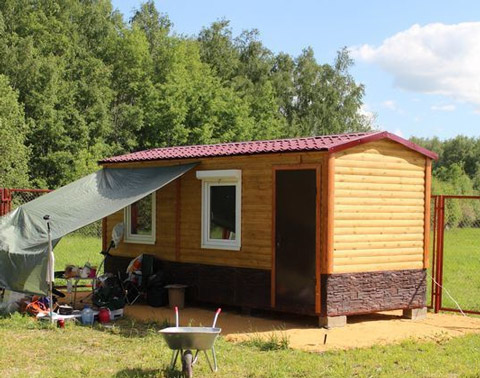
For a weekend summer cottage, there is no particular point in building a shed with a kitchen block: a summer kitchen fits perfectly under a canopy, see fig. right. If they go to the dacha, or live there, from spring to autumn, then they need a 3-in-1 change house with space for a kitchen and a stove for heating. An alternative is an electrified cabin; then they cook on an electric stove, but at the start dacha arrangement This is a rare case.
Veranda: immediately or later?
Change house with a veranda on summer cottage beneficial in many respects, if only because it can be used to equip a wind-protected kitchen and/or store household equipment, freeing up living space in the shelter. But a beginner does not need to immediately plan the construction of a cabin with a veranda: it will not be possible to get a sufficiently reliable and durable building without construction experience. It is better for a novice builder to build a simple “box”, and then add a veranda, which has no power connections with the main structure. The problem of connecting the foundations of the cabin and the veranda in this case disappears, because both are columnar, not buried, on a common anti-heave cushion. We’ll talk about what this all means later, but for now, just in case, see Fig. drawing of a shelter cabin minimum size with an attached veranda. It is being built using frame technology, and it’s time to get serious about it and the others.
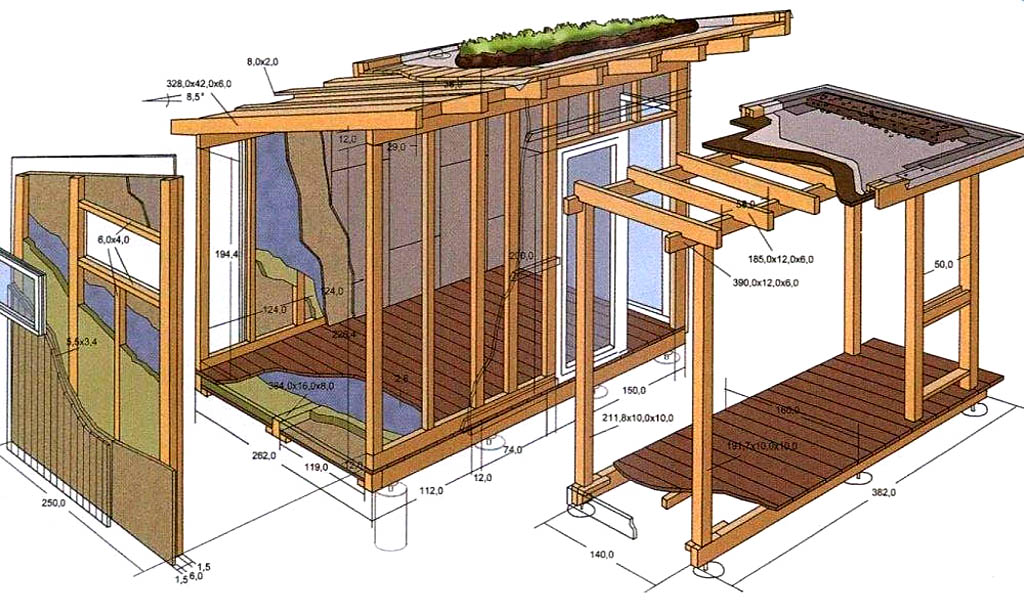
How to build?
Shields
The simplest way to build a cabin is a prefabricated one. The frames of the boards are assembled on the ground, then knocked into a box, on the left in Fig. A simple floor is laid in it, the walls are sheathed with anything: OSB, chipboard, plywood, etc. Then they install doors and windows (on the right in the figure), lay the roof - and you're done! For 1 season or less: a box made of panels is not a frame, there are no separate load-bearing elements in it, and under load the structure warps or even collapses even before the cold weather. A panel change house can only be built as a changing room-shelter and only if it is known for sure that the construction of the house will be completed before the fall.

SIP
However, the method of panel assembly of prefabricated, fairly reliable and durable buildings, incl. residential buildings available for DIY construction exist. This is an assembly of SIP panels (structural insulated panel, SIP, Structural Insulated Panel). A change house made of SIP will cost more than the frame one described below, but its construction will provide experience, which may be needed if you decide to build a year-round dacha or a country house from SIP; the technology in both cases is the same. Enough has been written about construction from SIP in RuNet, but for more details about the panels themselves, see the video:
Video: review of SIP panels
Watch out for shields!
Many of the ready-made cabins available for sale are panel houses, with all that it implies. If you decide to purchase a ready-made change house, you can weed out suspicious ones based on the following criteria:
- Good-quality cabins of any design, as a rule, do not have linings on the external wall cladding, pos. 1 in Fig. on the right, in contrast to the flimsy panel boards, pos. 2 and 3. These boards are stuffed onto the joints of the boards so that the product can withstand transportation.

- For the same purpose, the corners and openings of shoddy cabins are reinforced with temporary rough overlays, pos. 3. Good quality cabins can withstand transportation without strengthening the corners, and windows with glass are supplied in separate packaging. This trick doesn’t work with hackwork: when transported with empty openings, the booth is already warped so much that the windows won’t fit into place.
Frame as a basis
A strong rigid frame takes on operational loads. For such simple structure, as a change house, it also turns out to be inexpensive and little labor intensive. Frame cabins are built either “from the cage”, on the left in Fig. – the floor is laid in an already assembled frame – or a “cage” of power connections is assembled on a solid foundation, on the right there. The latter requires somewhat more labor and materials, but less skill, so further we will dwell on this method in more detail.

Beam and log
 Log and timber cabins look luxurious, see fig. on the right, but in cost and labor intensity they are not inferior to a house larger size, and are built using the same technology. They are rarely built, mainly if in the future it is planned to convert the change house into a bathhouse; frame buildings are not suitable for this. In this case, the change house is immediately built on the site of the bathhouse and equipped with a drain according to all the rules, and the stove, shower, and bathhouse equipment are purchased and installed when the house is ready.
Log and timber cabins look luxurious, see fig. on the right, but in cost and labor intensity they are not inferior to a house larger size, and are built using the same technology. They are rarely built, mainly if in the future it is planned to convert the change house into a bathhouse; frame buildings are not suitable for this. In this case, the change house is immediately built on the site of the bathhouse and equipped with a drain according to all the rules, and the stove, shower, and bathhouse equipment are purchased and installed when the house is ready.
Metal+
If you know how to do plumbing and handle a welding machine, then perhaps it will be easier for you to assemble a change house in a metal frame. In this case, firstly, there is no need for a foundation - the structure will simply stand securely on concrete blocks placed at the corners. Secondly, suddenly the change house is not needed, it can be sold without any problems at a profit.
The basis for a change house in a metal frame is the power circuit of the container, on the left in Fig. below, only for frames and corner posts, for the sake of economy, 80x80x(3-4) mm corrugated pipes will be used. The upper and lower battens are made from a paired corner 60x60 mm or a brand of the appropriate size. The floor is laid as described below for a frame cabin, and placed in the walls. wooden frames with openings for windows and doors and, possibly, with insulation, in the center in Fig; For frame designs, also see below. Usually, cabins of this type are sheathed on the outside with corrugated sheets, on the right in the figure, but this design allows you to make any type of sheathing, a gable roof, and give the building a complete wooden look while maintaining metallic strength.

We are building a frame shed
So, we came to the conclusion that our change house will be wooden frame. Step by step instructions construction of a frame change house 3x4.5 m has been wandering around the RuNet for a long time. Initially, it seems to have been compiled quite sensibly, but with repeated rewriting, errors and arbitrary abbreviations crept into the text. Following such instructions, a novice builder will be at a dead end during the work process or, acting according to his own understanding, will end up with a crooked and fragile structure. Unfortunately, source I seem to be completely lost, so I’ll have to turn to the available sources, but with explanations and notes.
The first of them: it’s impossible to build a change house “in 2-3 days”. Working from dawn to dusk without smoking breaks and carefully, avoiding mistakes, construction will take half a vacation in a row or 1-1.5 months, if you work on weekends. The last option is preferable, because It’s better to spend your vacation on a house and landscaping. In general, the first dacha summer will be anything but boring.
About impregnation
During the work process, all wooden parts must be impregnated with biocides (antiseptics) and water repellents (water-repellent compounds) before being installed in place. For household use, used motor oil is suitable as both. It is also highly advisable to treat the crown, bottom trim, floor joists and subfloor boards, see below, with bitumen mastic (40% bitumen and 60% white spirit or solvent). They impregnate not blanks, but parts already cut to size, with all the recesses, grooves, etc.
Foundation and base
In fact, any foundation is laid according to the so-called. worn out, but in this case, because the building is small, the work can be simplified if the site for the cabin is not too “humpbacked”. The basis of the change house is built in the sequence according to Fig:
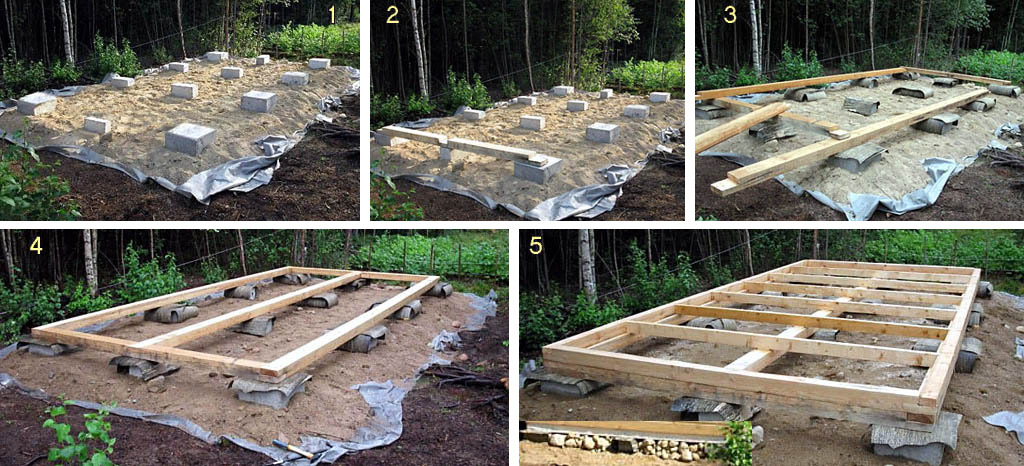
- Lay a columnar, non-buried foundation, pos. 1.
- A common support frame is assembled on it from timber 150x100 mm, the so-called. lower crown or, for a frame structure, just a crown, pos. 2-4.
- The lower supporting frame of the frame, or lower frame, with floor joists, pos. 5.
The choice of foundation type is clear: for such a small and light structure, any other will be unnecessarily complex and expensive. About the design and laying of columnar foundations, here we will dwell on the features specifically for this type of construction, which a beginner needs to know.
The pit for the foundation is dug with a grip (removal) of 0.5 m along the perimeter beyond the contour of the building. Remove humus; if the thickness of the fertile layer exceeds 30 cm, dig with a shovel. Otherwise, pits are dug under the pillars with a bayonet, i.e. up to 30 cm deep. Next, the pit is covered with geotextiles (so that the backfill does not spread) and first a sand cushion of 10 cm is poured, on thick humus, or in the holes under the pillars. Having placed the pillars, the pillow is filled to the ground level; its purpose is, together with anchors (see below), to counteract the forces of frost heaving. The sand bedding is compacted twice, before installing the pillars and after it.
The installation step of the pillars is within 1.2-1.7 m, so that a whole number of spans between them are laid on the sides of the building; for cabins 3x4.5 and 3x6, the step is 1.5 m. When digging holes for pillars, you need to take into account that the contour of the foundation should protrude beyond the contour of the building by 10-20 cm. All operational loads “flow” into the lower corners of the frame; if it lies flush on the pillars from the outside, then it will be difficult for them to “spread” in the pillar, and the building may slide to the side.
In no case should you lay brick pillars, as recommended in the sources: the best working brick in the ground will begin to crumble in a maximum of 3-5 years, dry-molded facing bricks will begin to crumble in the first winter, and durable high-burnt clinker will cost more than special concrete foundation blocks 200x200x400 mm. There will be 4 blocks per post, laid crosswise in pairs on a cement-sand mortar; for more details see about columnar foundations. Thus, the pillar will turn out to be a cube of 400x400x400 mm, of which 200 will be in the ground (30 cm bayonet minus 10 cm cushion), and 10 cm from the outside will be taken out. For a change house 3x4.5 m, the dimensions of the foundation along the contour will thus be 3.2x4.7 m, and the dimensions of the pit in plan will be from 4.2x5.7 m.
Now let's look again at pos. 1. See? The pillars of the middle row are narrow, each made of a couple of blocks. This is actually wrong even for places with mild winters; all pillars should be the same. Foundation blocks are not so expensive that you need to save on them in the most important part of the structure.
The posts are first placed on a dry surface and leveled horizontally using a hose gyro level; adjust the height by adding sand under the low pillars. The rectangle is drawn by measuring the diagonals and sides. You cannot rely only on the equality of the diagonals; instead of a rectangle, you may end up with an isosceles trapezoid! Having aligned the pillars, the upper pairs of blocks are removed and placed back on the mortar.
Next, prepare the base (short) beam of the crown, try it on in place and lay it perpendicular to the long axis of the building, pos. 2. Trying on it, cut the remaining bars 150x100 to size; the crown is assembled flat, i.e. The 150 mm side is oriented horizontally, pos. 3. All connections are half-tree. Don't forget about impregnation! After fitting, the beams are removed, the pillars are covered with 2 layers of roofing material (this is waterproofing against the so-called capillary soaking of wood), the beams are put back and, after checking the crown with diagonals and side measurements, the joints of the beams are sewn together with 80 mm nails, a pair diagonally in each joint, pos. 4. At this stage, the foundation is strengthened with anchors.
Anchors
Foundation anchors are the same “steel bars from 1 m” from the descriptions that seem to need to be walled up in pillars. In fact, it is easier and more reliable to fix a change house, the pressure from which the ground is like pellets to an elephant, with L-shaped crutch anchors driven into the ground, pos. And in Fig. to this paragraph. Crutches are made from corrugated 16-mm reinforcement. Their lower ends are sharpened so that they go into the ground easier and, most importantly, more evenly.

The anchors are hammered in from the inside, a 20x20 mm groove is made in the crown beam under each crutch bar: they are filed along the edges and selected with a chisel. Don’t overdo the cuts; there’s no point in loosening the crown too much! The anchors are driven in according to the diagram, pos. B and C for cabins 3x4.5 and 3x6, respectively, in 2 steps: first, they do not finish off 10-15 mm, and then, after measuring again and trimming the crown, if necessary, they finish off tightly according to the same patterns; preferably with 1 hit with a sledgehammer. Additive in Fig. we will need more information about corner nails below.
The next stage is the application of the lower trim to the crown and installation of the floor joists, item 5 in Fig. with a base device. The harness is made in the same way as the crown, but from 100x100 mm timber. Assemble flush with the outer edge of the crown; Thus, a 50 mm step is formed inside, on which the logs will lie. After application, the frame of the harness is fastened along the insets with 80 mm nails, also like a crown, and sewn to the crown with 150 mm nails, as shown in Fig. with anchor layout diagrams.
The logs are made from 100x50 timber or 100x40 boards; they are cut into the framing timber by a quarter or a third, i.e. The mustache of the logs will be 25 or 30 mm high. The installation pitch of the logs is 400-700 mm. It is chosen so that the spans between the lags are the same width. If the finished floor is made of a simple edged board, it is better to stick closer to a smaller value, and if it is to be tongue-and-groove, then the lag pitch can be increased. In any case, it is advisable to take it in multiples of 150 mm, this will greatly simplify and save flooring, see below. Each lag is nailed to the frame with 2 80 mm nails, one nail at a time, and in the center to the crown with a 150 mm nail, for a total of 3 nails per lag.
Underground
At the same stage, it is desirable, and for a change house “from spring to autumn” that is heated at least for a short time, it is necessary to insulate the subfloor, otherwise the floor will become damp. To do this, the openings between the foundation pillars are filled with something (ruble stone, broken brick, paving slabs), insert into pos. 5 in Fig. with a base, on a cement-sand mortar, and the subfloor is covered with expanded clay. Careless builders often simply lean scraps of corrugated sheets or broken slate on the outside, pressing them into the sand, and sprinkle the outside with soil. You can also foam it if you don’t mind the foam.
There are some subtleties here. Firstly, the purpose of filling the openings is only to keep the expanded clay from spreading, but you cannot cover them with sheet material from the inside: the subfloor must be ventilated, otherwise it will turn into a condensate collector. Therefore, in each span you need to leave either vents, a pair of about 4x6 cm per span (convenient if filled with rubble or broken bricks), or a gap at the top of 4-6 cm. If the spans foam, you need to insert pipe scraps under the vents in advance.
Secondly, the openings need to be filled from the inside so that the filling does not stick out. Then later, when you get the hang of it and the structure settles, you can make a real beautiful base.
Frame
The first to install the corner posts of the frame are made of 100x100 timber, reinforced with temporary struts (item 1 in the figure), on steel corners and self-tapping screws (5-8) x (60-70) mm, pos. 2. The screws are tightened tightly after the stand is plumb and supported with jibs. The height of the rear pillars is approximately 2.2-2.4 m; can be taken from the mini cabin drawing, see above. The front ones, with a building width of 3 m, are taken 0.5 m longer. If you calculate the dimensions of the racks yourself, keep in mind that the maximum slope of a slate or ondulin roof is 14 degrees, and the optimal one is 7-9 degrees.

Next, the longitudinal upper side beams of the box are applied (talking about a solid top harness in the form of a supporting frame in this case is not necessary), attaching from below with corners, as below, and cutting transverse beams into half the tree. The crossbars are fastened with 80 mm nails, a pair diagonally in each insert. After this, install the intermediate posts and the corresponding upper cross members, pos. 3.
At this stage, construction can be somewhat simplified and cheaper. At pos. 3 you can see that the intermediate racks are also made of 100x100 timber, but for a small change house this is unnecessary; 100x50 beams or 100x40 boards, the same as for logs, will be used for the intermediate racks. They are placed across the strapping bars. To ensure that the structure does not lose strength, the following conditions must be met, see fig. right:
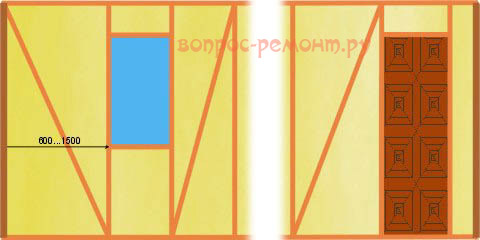
- The spans adjacent to the corners should all be the same width.
- Corner spans and those adjacent to window/door openings must be reinforced with jibs made from the same board.
- If the corner/adjacent span is 300mm or less, this situation should be avoided by placing doors/windows at a sufficient distance from the corners.
Now you need to replace the temporary jibs with permanent ones, from the same 100x40 board, and install the rafters, pos. 4. There, by the way, it is clear that the builders made a mistake: one of the corner spans is empty, although nothing prevents us from reinforcing it. Strut boards are also placed across the beams; fasten with 80 mm nails, a pair at each end. Next comes the installation of door jambs (you can immediately with the door leaf) and window frames, pos. 5. The installation of the box is completed by fastening the bottom chord to the crown using 150 mm nails with a pitch of 200-250 mm.
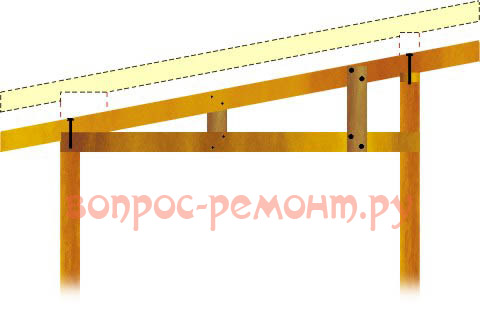
Rafters
How the rafters are cut in and installed is shown in Fig. The installation pitch of the rafters is approximately 0.5 m. Additional hangers are made from scraps of boards. In this design they are highly desirable, because It is not possible to firmly attach each rafter to the beams of the upper chord. The overhang of the rafters is approximately 30 cm; The side overhang of the sheathing under the roof will be the same. If the cabin is constantly in the wind (say, in the forest), then you can do without rafter hangers.
Perhaps a dull pitched roof will not suit you. In such a case, in Fig. Below are diagrams of roof trusses suitable for a country house and, of course, a change house. The designs outlined in green are good because they are simple, economical and allow you to reduce the height of the corner posts to 1.9 m while maintaining a sufficient height of the cabin ceiling.
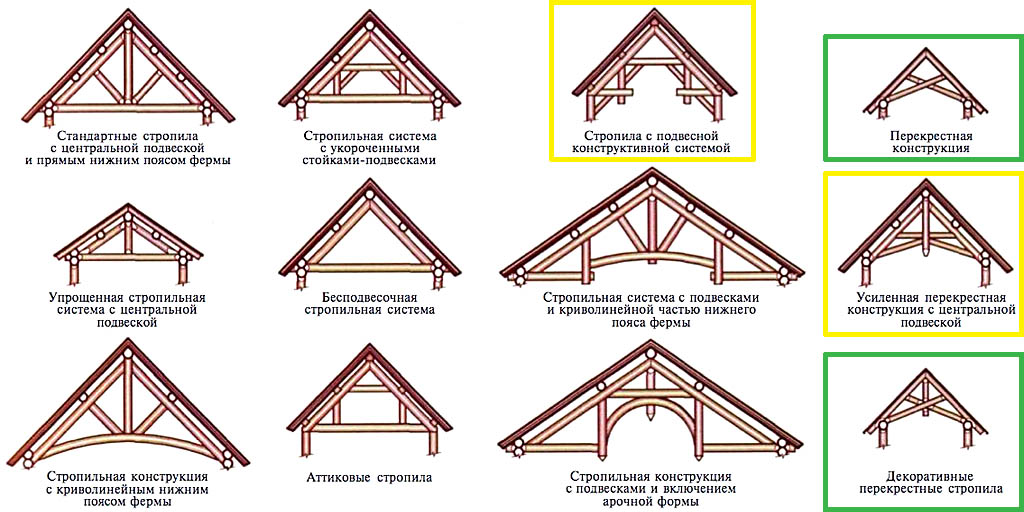
Roof
After assembling the frame, the roof is covered so that rain does not wet the unfinished floor. Its sheathing under a slate roof is assembled at intervals (on the left in the figure), and under an ondulin roof it is continuous, because ondulin is a soft material. Working with it, of course, is easier than carrying heavy, fragile slate sheets, but slate roofing is much cheaper and more reliable.
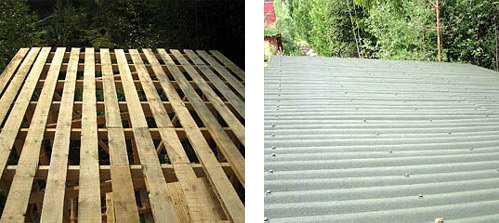
How slate roofing sheets are laid and secured is clear from Fig. below, but when purchasing it you need to take into account some circumstances. First, most often there are 6, 7 and 8 wave slates on sale. 6-wave sheets are lighter, but the price per square of roofing from them will be significantly higher than from 8-wave sheets. So, if you have little money and are not afraid of work, take the 8-wave.
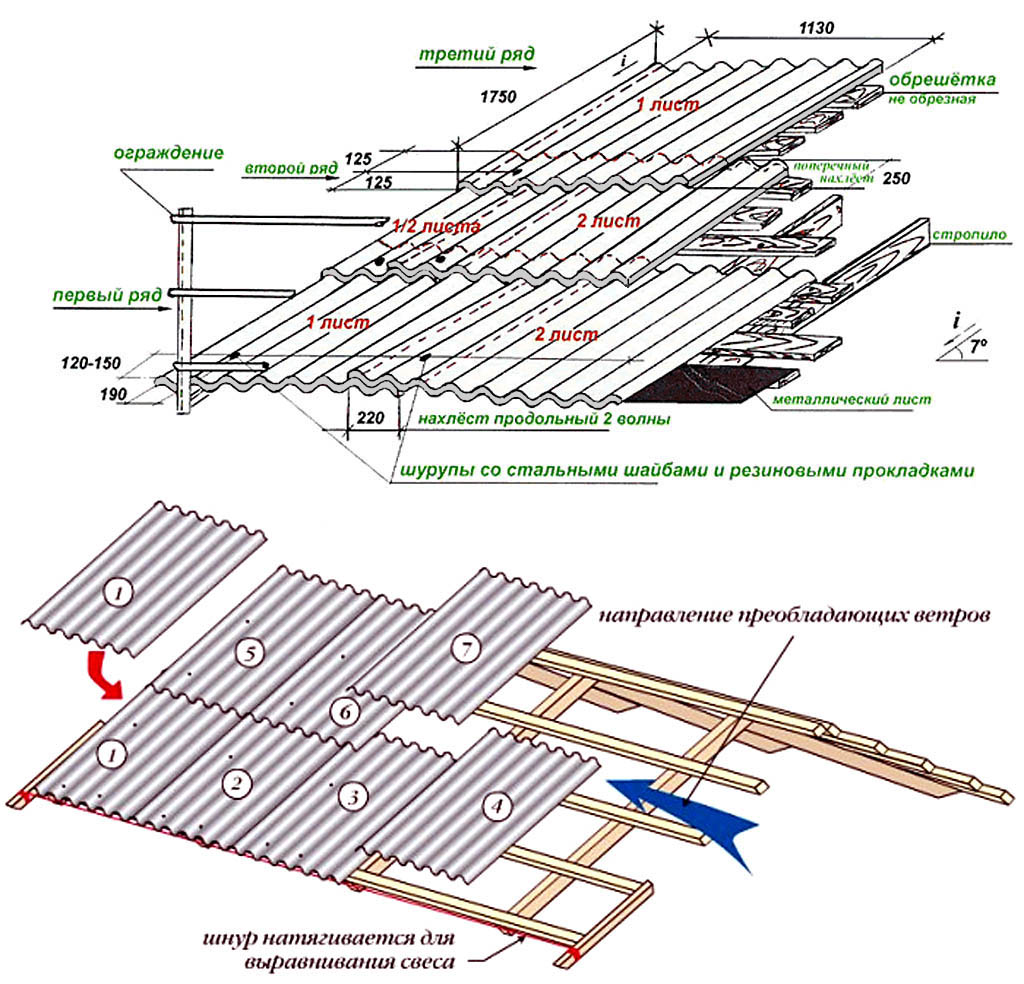
Secondly, slate sheets are produced in different pitches, wave heights and thicknesses. If you take a used one or anything random, it may turn out that the sheets do not fit together. Therefore, when purchasing, you need to pay attention to the markings; there is always a set of 1, 2, 3 and 4-digit numbers, for example. SHEET 40/150 – 1750 – 8 or 6-GOST 40/194/1750. 8 or 6 then will be the number of waves, 40 is the height of the wave, 194 or 150 is its step, and 1750 is the height of the sheet, this is its standard value. If there is a smaller 4-digit number, then this is the width of the sheet.
Floor
The floor of the change house consists of 2 floorings, the lower rough and the upper finishing, with heat, hydro and vapor barriers between them. Nothing can be simplified here, otherwise the room will turn out damp, uncomfortable and will soon rot. In addition, the crown with the strapping and plank flooring form a rigid box, without which the entire base will be fragile. So you need to approach the flooring with the utmost care and attention.
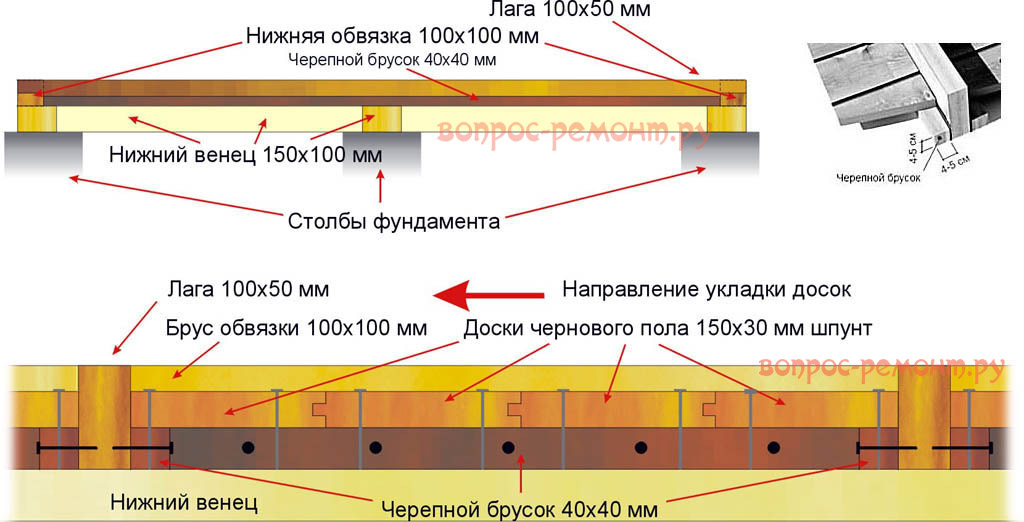
How the subfloor is constructed can be seen from Fig. The skull block is placed along the entire contour of the openings between the lags; “nail” with 70 mm nails in increments of 100-120 mm. It is needed to include the flooring boards in the power circuit. For the subfloor only use a 150x(30-40) mm tongue and groove board! You can still save on finishing flooring by making it from a simple edged board, but the “sub-floor” floor is laid only with tongue and groove! The sequence of flooring operations is as follows:
- Boards are placed along the openings between the joists.
- From the first board, in order of installation, the tongue groove is cut off.
- The next boards, up to and including the penultimate one, are placed by pushing the groove tightly onto the ridge of the previous one.
- The last board is cut to size along the width from the ridge side, i.e. cut off the comb with part of the face.
- They place it obliquely so that the groove fits onto the ridge of the previous one, and forcefully press it into place; You may have to tap it with a mallet.
- The boards of the finished flooring cell are nailed to the skull beam with 70 mm nails in increments of about 100 mm, and with a pair of nails in the middle of each to the middle beam of the crown. The distance of the nails from the edges of the longitudinal boards is no less than its thickness, i.e. 40 mm. It is also advisable to maintain it for the cranial beam, driving the nails in obliquely.
When the rough flooring is ready, pos. 1 on next Fig., its cells are covered with glassine or its analogues, this is a vapor barrier. You cannot save money by insulating the bottom with polyethylene, because... it allows both vapor and moisture to pass through. Glassine is sewn to the joists with a construction stapler or nailed with small nails, placing pieces of plywood under their heads. In any case, you can’t sew/nail it to the flooring - what kind of insulation will it be, with holes at the bottom?

Now it’s time to insulate the floor. Let us remind you once again that it is also necessary in a summer shed to prevent it from getting damp. You won’t store it in a heated room in winter, will you? Insulate mineral wool pos. 3, but you need to take mats from long-fiber mats suitable for residential buildings. Short-fiber mineral wool will constantly accumulate dust with microneedles, which are very harmful to health!
Next, the floor is covered with a continuous sheet, or with overlapping sheets of 15 cm, with plastic film, pos. 4. Now the semi-permeability of polyethylene will be just right: the condensate that did get into the floor will evaporate through it, without having time to cause rotting, and the liquid spilled on the floor will also evaporate or drain before seeping into the insulation.
The last “floor” operation is finishing flooring. It is also advisable to make it from tongue and groove, but, as already said, a simple clean-edged board 150x40 mm will also work. “Clean” boards are laid across the joists, i.e. perpendicular to the “black” ones, pos. 5. The finishing flooring is carried out “solidly”, from edge to edge of the frame of the lower trim. Do the so-called. a floating floor, as in a residential building, is not allowed in a change house for reasons of structural strength.
In places where the flooring boards fit on the frame posts, grooves of 50x100 are chosen in the boards, and corners of 100x100 are chosen for the corner posts, so you cannot take a 100-mm board onto a clean floor; the corners of the flooring will come out hanging. “Clean” boards are nailed in the corners with pairs of 70 mm nails diagonally (into the edge of the board and in its corner), and at other intersections with beams and joists - in pairs of the same nails across the board.
Sheathing

The outer sheathing gives the final strength to the structure, so it is also made from boards, and siding, etc., whatever you want later, is sheathed on top of it. They are sheathed either with tongue and groove or with a quarter board, so that the water flowing down the walls does not seep inside, i.e. up with the ridge of the tongue or the inner quarter, see fig. right. If no further external finishing is expected, then you can sheathe edged board cover, "herringbone". They are sheathed from top to bottom, including the lower belts of the base. Before covering, glassine is stapled to the frame, pos. 1 and 2 in Fig. Now you can install windows; Before installing the trim, the cracks in them and doorways are foamed, pos. 3.

As for the internal cladding, here - as God pleases: plywood 4-8 mm, OSB, chipboard, laminate, etc., with or without insulation, pos. 4 and 5. At the same stage, corrugations are laid in the walls with cables pulled into them, if the change house will be electrified.
Insulation, if necessary, is the same as for the floor. It is advisable to cover the corners with baseboards. In Khrushchev's times they often did without interior decoration, there were simply no materials. Now it’s easier with them, no matter who is nostalgic for those times.
Partitions
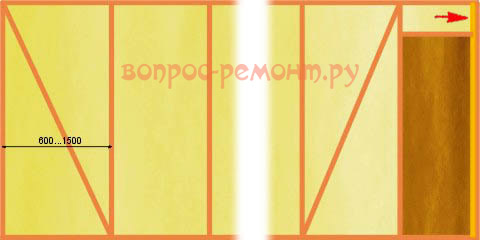 The frames of the partitions, if any, are assembled according to a pattern similar to the sidewalls of the frame, see Fig. on the right, only from slats 40x40 mm. The jibs are placed only in the outer cells. Internal doors often have to be placed close to the wall, then an additional rail is placed in the cell with the doorway (shown by the arrow), without it the door in the frame will not fit into place. The partition frames are put in place, nailed with 70 mm nails in increments of 200-250 mm directly to the walls, and sheathed with the same material as interior walls. The corners are reinforced with plinths along the entire contour.
The frames of the partitions, if any, are assembled according to a pattern similar to the sidewalls of the frame, see Fig. on the right, only from slats 40x40 mm. The jibs are placed only in the outer cells. Internal doors often have to be placed close to the wall, then an additional rail is placed in the cell with the doorway (shown by the arrow), without it the door in the frame will not fit into place. The partition frames are put in place, nailed with 70 mm nails in increments of 200-250 mm directly to the walls, and sheathed with the same material as interior walls. The corners are reinforced with plinths along the entire contour.
For reference
Blade width entrance doors– 800-1100 mm, interior 750-850 for residential and 600-750 mm for utility rooms, utility rooms and bathrooms. The maximum sash width of a single-leaf window is 900 mm; preferably 600-650 mm. A sash width of 400 mm is considered the minimum, but it can be made narrower. Door height – 1900-2100 mm; windows – 600-1300 mm. The height of the window sill above the floor is 750-850 mm.
More angles
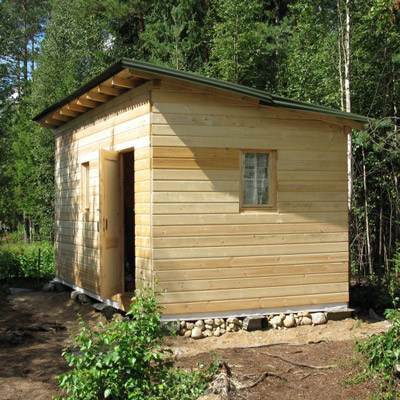
Remember how we installed the corner posts of the frame: on steel corners. Perhaps you already noticed that the outer, most loaded corners of the frame from the point of view of construction mechanics are hanging, i.e. weakened. Therefore, it seems that the change house in Fig. is quite ready. in fact, it is not yet ready to take on everything that fate and the weather have in store for it, its outer corners need to be reinforced with overhead boards.
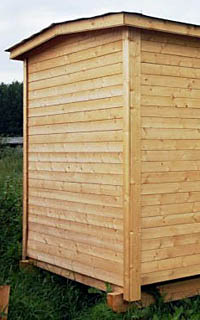
How this is done can be seen in Fig. left: the corners are sheathed in pairs of boards from top to bottom. Scheme for driving nails (150 mm): 1 at a time into the crown and bottom trim, then in a row with a step of 200-300 mm to the racks, then 1 at a time into the upper horizontal beams. First, boards are nailed along the short sides of the building flush with the edge of the corner, and then on the long sides to cover the ends of the adjacent ones.
About shutters
The fact that it is highly desirable to equip the windows of the cabin with shutters is obvious: the winter elements are capable of breaking the glass even without the participation of hooligans. But it is difficult to make swing shutters in a change house, and blinds are needed for them, because... In the hot summer, a room without a ventilation system will be stuffy. Therefore, the best option for shutters for change houses is folding ones, see fig. They shade windows like awnings, protect glass from damage better than swing windows, and are easier to make.
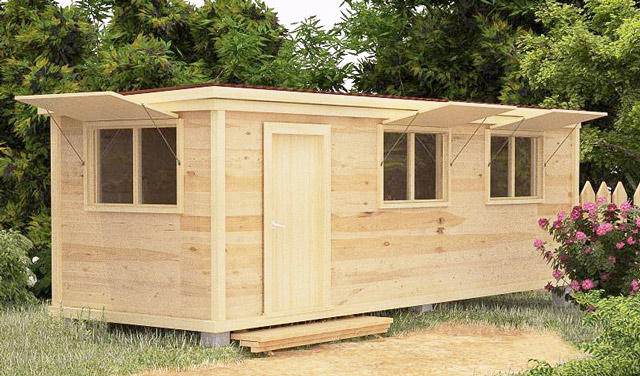
Carriages
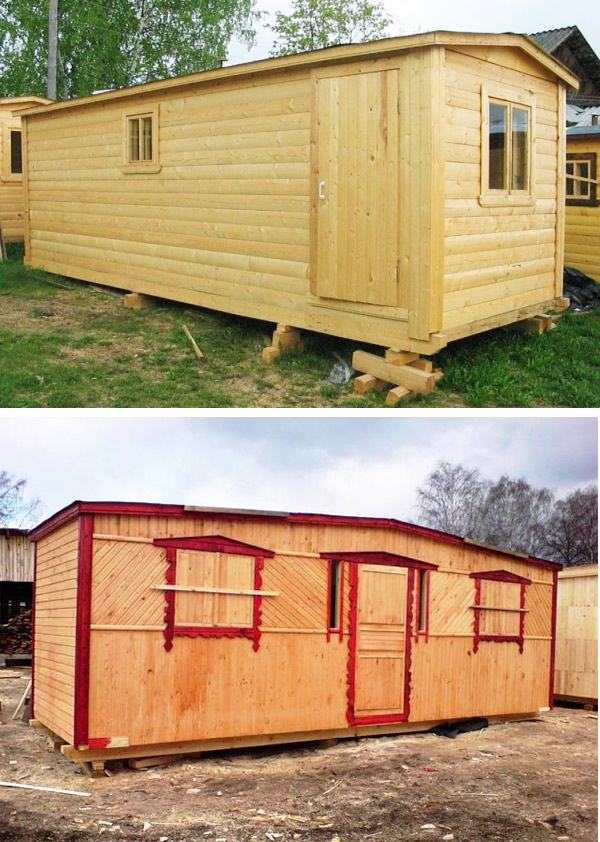
Construction trailers come in lengths of 6-12 m and a width of 2.4 m. A cabin trailer 6 m long turned out to be very convenient for a dacha: a lot of things can fit in it, and it can be placed without problems even on 6 acres. It was only necessary to increase its width to 3 m, because... The walls of a frame cabin are thicker than in a standard trailer. Change houses of this type, see fig. They are always on sale and sell well.
However, with the development of the needs of summer residents, with often insufficient opportunities to build a comfortable house on the site, problems arose with the layout. Typical construction and traveling change house-vest, pos. 1 in Fig. below, this is only the bedroom and/or dressing room. For kitchens, dining rooms, bathrooms, offices, even bars and billiard rooms, other types of trailers of the same size have been and are being produced, but the summer resident has nowhere and no money to assemble an entire town on the site.
Attempts to use sanitary-ergonomic techniques and standards for residential premises in the layout of cabins lead to the fact that, in addition to the bedroom, there is only room left for a tiny vestibule, in which you cannot turn around in warm clothes, and a warehouse, in which there is nothing but a shovel and a rake. does not fit, or a toilet without a shower, where, while sitting, the door cannot be closed - it rests on your knees, for example, in the center in Fig.

Since the change house is essentially a mobile home, it would be quite justified to apply the techniques and standards of passenger transport to its layout. The only problem will be with the doors, or more precisely, with the direction of their opening, because... They are hinged, not sliding. But the doors, in general, are second after headache planners.
An example of a rational layout of a 6x3 m shed is shown on the right in Fig. higher:
- The bedroom is 1.7 x 2.7 m larger than a railway compartment. It will fit a bunk bed, a small dining table and a chest of drawers. At night, you can also place a cot on the floor, for which, among other things, there is enough space in the warehouse.
- The bathroom has a corner shower 1.1 x 1.1 m, a bio-toilet and a corner half-tulip washbasin, similar to the ones on the railway. It’s not a luxury, but you can wash yourself and relieve yourself.
- The largest area is allocated for the kitchen block, combined with a vestibule, these are the 2 highlights of this principle. It fits a compact refrigerator, a country stove with a hob with 3-5 kW of thermal power (enough for heating in the off-season), and there is still room to change clothes; and in the warmth.
- The exit from the bathroom is also into a warm room, which is important after a shower in cold weather.
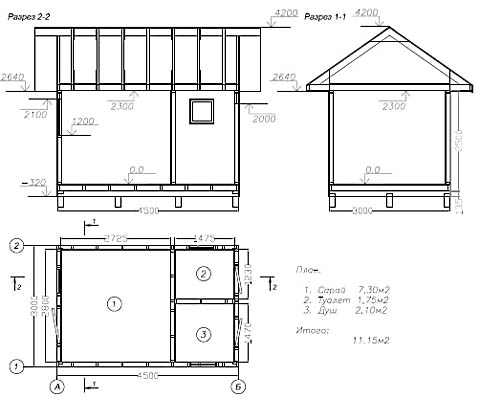
With smaller cabins the situation is more complicated; here you have to combine a storage shelter with a kitchen. An example of the layout of this kind of “studio cabin” 3x4.5 m is shown in Fig. right.
And then?
Guess what, the next person at the dacha, as they say, will scream: “Build me!” Perhaps when the house is not yet ready, and the bathhouse is only in dreams? That's right, a barn. Either a poultry house or a pigsty, which is almost the same in design.
The situation is peak. How to build it? Where can I get time if I already need more of it than there are hours in the day? And most importantly - from what? There is no extra money and is not expected.
Pallets made from pallets of building materials. There are probably some left over from the construction site, and it’s not expensive to buy more used ones: dismantling pallets into irregular lumber with holes from nails is absolutely unprofitable, so used pallets are often sold off cheaply just to get rid of them.
Over time, everything fits in for an extraordinary construction project: a barn or pigsty for 1-2 pigs can be built from pallets in literally half a day. And how - see for example. in the video below. Although, of course, a good quality barn, poultry house, rabbitry or pigsty is a subject of special discussion.
Video: a shed made of pallets and junk